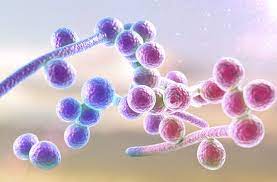Candida albicans or yeast is part of our natural microflora — or the microorganisms that commonly live in or on our bodies. It can be found in the GI tract, the mouth, and the vagina.[yeast] Most of the time it causes no issues, but it’s possible for overgrowths and infections to happen. Candida albicans is the most prevalent cause of fungal infections in people. Its species name, albicans, comes from the Latin word for “white.” The yeast appears white when cultured on a plate.
And in the case of certain infections, like thrush, it can create white patches. We look more closely at types of Candida albicans infections and how they’re treated.[yeast]
Types of Candida albicans infections
Below, we’ll explore the causes, symptoms, and treatment of four of the most common types of Candida infection. In the next section we’ll go over the less common infections that Candida albicans can also cause.
Urinary yeast infection
Candida species are the most common cause of fungal urinary tract infections (UTIs). Candida UTIs can occur in the lower portion of the urinary tract or in some cases can ascend up to the kidneys.
The following can put you at risk of developing a Candida UTI:[yeast]
- having taken a course of antibiotics
- having a medical device inserted, such as a urinary catheter
- diabetes
- a weakened immune system
Symptoms
Many people with a Candida UTI don’t have symptoms. If symptoms are present, they can include:
- an increased need to urinate
- a painful or burning sensation when urinating
- abdominal or pelvic pain
- blood in your urine
Treatment
Treatment is only recommended for symptomatic individuals. The antifungal drug fluconazole can be used in many cases. If a catheter is in place, it should be removed.
Genital yeast infection

Sometimes the infection is present in female vagina and have various symptoms
Candida albicans is the most common cause of genital yeast infections. Normally, a type of bacteria called Lactobacillus keeps the amount of Candida in the genital area under control. However, when Lactobacillus levels are disrupted in some way, Candida can overgrow and cause an infection. You can also develop a Candida genital infection after participating in certain sexual activities, particularly those that involve oral-genital contact.[yeast]
Although otherwise healthy individuals can get genital Candida infections, the following groups are at an increased risk:[yeast]
- people that have taken antibiotics recently
- people with uncontrolled diabetes
- immunosuppressed individuals
- pregnant women
- people that are taking oral contraceptives or who are on hormone therapy
Symptoms
Symptoms of a genital Candida infection can include:
- a burning feeling while having sex or while urinating
- an itchy or painful feeling in or around the vagina
- redness, irritation, or swelling around the vagina
- abnormal vaginal discharge that can be either watery, or thick and white
- a rash around the vagina
- a rash on the penis
Candida species can also infect the male genitals, often if their partner has a vaginal Candida infection. The infection may be asymptomatic, but can cause an itchy or burning rash around the head of the penis.
Treatment
Mild or moderate genital Candida infections can be treated with a short course of an over-the-counter (OTC) or prescription antifungal cream, pill, or suppository. You could also be prescribed a single dose of an oral antifungal medication, such as fluconazole.[yeast] For more complicated infections, you may be prescribed a longer course of medication, either in the form of a cream, a pill, or an ointment.
How are Candida infections diagnosed?

Oral thrush infections when left untreated can lead to candida albicans
In order to diagnose candidiasis, your doctor will first take your medical history and ask you about your symptoms. They may also ask if you have any conditions or medications that could lead to a weakened immune system, or if you’ve taken a course of antibiotics recently. Many common cases of candidiasis can often be diagnosed through a physical examination.
If your doctor is uncertain if your symptoms are due to a Candida infection, they may take a sample from the affected area. This sample can then be used to culture the organism and to identify what species it is. For example, if candidemia is suspected, your doctor will collect a blood sample for testing. Identifying the species of Candida that’s causing your infection is also helpful because your doctor will be able to prescribe an antifungal medication that will be effective in treating that particular species.
Candida albicans and you
Normally, Candida species are a part of the natural microflora of the GI tract, skin, and vagina, and don’t cause disease. Some circumstances, such as taking a long course of antibiotics or having a weakened immune system can increase your risk of developing a Candida infection. The most common Candida infections, such as vaginal and skin infections, are localized and can be treated with antifungal drugs.
An untreated Candida infection carries the risk of leading to a systemic infection in which other organs can become involved.[yeast] If you notice symptoms that are consistent with those of a Candida infection, see your doctor in order to receive the proper diagnosis and treatment.
Internal links:
How to protect yourself from bacterias such as Escherichia coli, Salmonella, Clostridium
The racehorse bacterium (Lactobacillus equicursoris)-Erakina
Date: 30/12/2021






